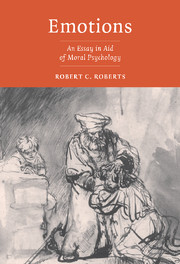4 - The Play of Emotional Feelings
Published online by Cambridge University Press: 03 December 2009
Summary
EMOTIONAL ERROR
In Section 2.2 I noted that when philosophers distinguish emotions from feelings, the feelings they usually have in mind are the sensations of body states that typically accompany some strong emotions: muscular tightness in face and neck and arms, goose pimples, abdominal perturbations, and so on. I agreed that such feelings are not emotions, and was led into the exposition of my basic account of emotions by identifying a kind of feeling that is very far from being a bodily sensation, namely feelings of triumph, of awkwardness, of having been ripped off, and so on. These feelings of states or qualities of the self I called feelings of construed condition. This observation gave us the concept of a kind of feeling that is, for ordinary purposes, indistinguishable from emotion. It is this concept of a feeling of an emotion – and not that of a sensation that may or may not accompany an emotion – that justifies the interchangeability in many ordinary language contexts of “emotion” and “feeling.”
Robert Kraut once tried out the thesis that emotions are feelings in a certain kind of context: “Just as a piece of wood, when caught up in the appropriate conventions, qualifies as a pawn, a certain feeling, when occupying a specifiable position relative to the causal order and the order of social practices and communal norms, qualifies as an emotion.
- Type
- Chapter
- Information
- EmotionsAn Essay in Aid of Moral Psychology, pp. 314 - 352Publisher: Cambridge University PressPrint publication year: 2003



